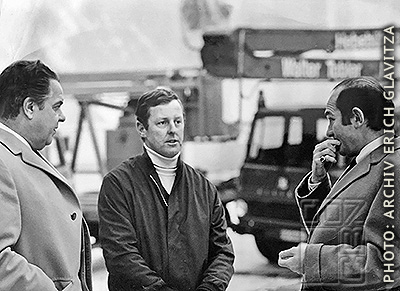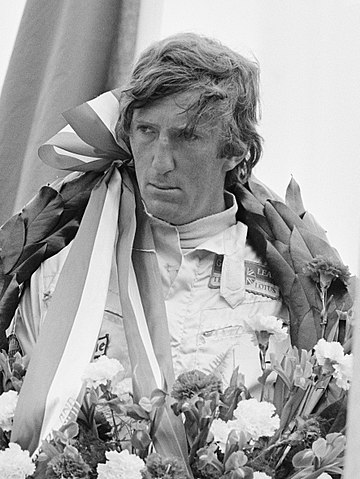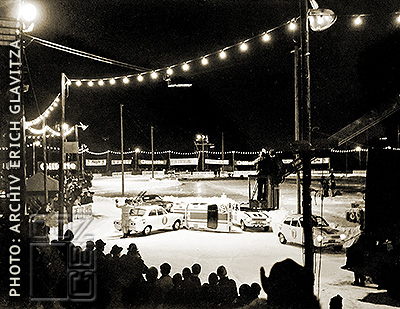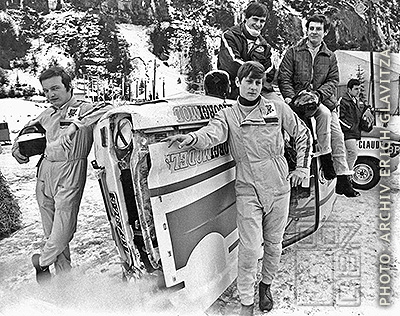Driving Miss Tracy – The Erich Glavitza CBn Interview Part 3

In part One and Two of this interview, former racing and stunt driver Erich Glavitza from Austria told us how he got the job as a stunt driver for the 6thJames Bond movie “On Her Majesty’s Secret Service”. We also heard about his preparations, how he managed to get enough cars, the necessary equipment and find the drivers. After that, he told us about the rehearsals, working with the movie crew and how he taught Dianna Rigg how to drive on ice. It is widely known that back then, leading actor George Lazenby wasn’t the easiest guy to work with, and Glavitza told us about this special experience, too.

In this third and final part, we’re going to hear about the shooting of the car stunts. Also, Glavitza reveals the hitherto virtually unknown names of the other drivers – as far as he remembers them 50 years later – and talks about his life after Bond.
Erich, after we heard about all these preparations, please tell us about the actual shooting…
About time, eh? (laughs) We started with the scene at the telephone booth in Lauterbrunnen with the Cougar driving off with screeching tyres. I had some concerns, and said “Screeching tyres on an icy road? Not even a hamster would buy that.” But Peter Hunt just shrugged it off and said “No one will notice that, anyway.” And he was right – nobody did. Then came the pursuit before the race, which was shot on the road coming from Grindelwald. When that was done, we did the opening scene of the race with me crashing through the gate.
During those weeks of shooting, a lot of ‘groupies’ had gathered, first in Mürren only, then in Lauterbrunnen, as well. I had met a beautiful girl named Candy, who desperately wanted to be in the movie as an extra. I spoke to Hubert Fröhlich who made it possible. When I crash through the gate, she’s one of the people who jumps out of the way. She was … erm … very thankful for that (laughs)– hey, that was the 60s…
For the next few days, we shot the racing scenes. My friend Peter Huber was the driver of the Mercedes – but he’s not the guy you see driving it in the movie, that was an actor. He was a bit too careful at times when it came to drifting towards the cameras in the aluminium tubes. Peter Hunt was not happy with that and he wanted me to drive the car in order to get more action. But I declined and talked to Huber instead. I said “That camera is not your mom! If you hit it and it gets blown to bits, so what?” That worked. His reluctance was gone all of a sudden and he became an excellent stunt driver. At one point, I even heard Peter Hunt mumble “He’s a beast.”
And then came for what you were initially hired: the overturning cars.
The first one was the one with the Escort. I drifted sideways onto a flange which we had cut into the ice. The impact caused the car to stop abruptly, resulting in the overturning. The angle wasn’t perfect the first time, so I needed a second take. Tyrolia later used a picture of me and the car with the ripped off front tyre for an advert in an English sports magazine with the caption “007 Glavitza was here”.
But that wasn’t how the stunt was originally planned by you.
I had a hidden ramp built next to the fence which I wanted to use for that. But due to script changes, it was decided to use that one for the Mercedes stunt instead. It was my idea to have Tracy’s Cougar ram one of the Escorts which would then kick out the Mercedes. I thought it to be more realistic to have the overturn evolving from a race-like scene. I remember that I explained my idea using different boxes of cigarettes. When the stunt was finally done, Peter Hunt was happy when he saw the old Mercedes lying on his back like an old turtle. It had begun to snow, so he called for a break. We all went into the crew tents, had some tea and cookies and when we went outside again after an hour, the whole situation had changed. About one meter of snow had fallen, I hadn’t seen such heavy snowfall in all my life. Luckily, the technicians had pulled a large tarpaulin across the Mercedes. Half an hour later, it would have been impossible to find it under the snow. Hubert Fröhlich had a lot of organising to do to have the street cleared and make it possible for us to return to the hotel. It kept snowing all night and the next day, and the next one and so on – for five days. We couldn’t even leave the hotel as there were two meters of snow around it. Avalanches were going down, one of them covering the rear part of the valley with 15 meters of snow, only 200 meters behind our race track. The Swiss army came with heavy equipment to clear the most important roads, we heard them roaring through the valley. But despite their use of tanks and huge snow-ploughs, we were stuck for three weeks. Which I didn’t really mind, as every day was fully paid (laughs).
There certainly was a lot of effort necessary to clear the ice track and make the whole set look like before the snowfall.
We needed the first day just to get to the race track, and we had to use avalanche probes to find the Mercedes. We shovelled for five days, with Hubert Fröhlich yelling orders like a sergeant all the time, until we were finally able to shoot the explosion scene. The thing was, the explosion didn’t make any sense at all. Why should a car catch fire and explode, just from overturning? That was completely unrealistic. But, hey, it was a James Bond movie, anything may happen. On the other hand, they mounted drilling machines into the wheelhouses that kept the wheels spinning like it would have been immediately after the crash. The explosion was shot in two takes because the flames and smoke would interfere with the lighting, depending on the angle. We climbed into the Mercedes, then we got a signal and jumped out and behind us, the big bang went off. In the final film, it looks much more dramatic than it really was, we could have done that 20 times without anyone getting harmed. The special effects guys worked miracles with their explosions.
Another thing that had to be done was sound recording. The sound engineers wanted me to do some crashes with big bangs. I had planned to “t-bone” one of the Escorts at 50 km/h, but somehow I didn’t pay attention and so the crash happened at 70 km/h, which is a bit different. I thought my eyeballs would pop out. The safety belt’s bolts had been ripped out of the body sheet and I just sat there, dumbstruck and panting for air for several minutes. One spoke of the steering wheel was bent, steam was emerging from the radiator and something must have been wrong with the accelerator cable as the engine was roaring at full speed. The sound engineers were cheering “That was great, Erich – can we do it again?”
I had our mechanic do some extra preparations on one of the Escorts’ bumpers and safety belts, and after that, I did it again – and again – and again. My right shoulder was already badly bruised, so I tried to keep it at 50 km/h from then on.

details with director Peter Hunt (right).
If anyone can tell who’s the man
in the middle, please let us know.
But all good things come to an end sooner or later…
That’s the way things go. One night after shooting, we had a final meeting with the team and the director and that was it. I knew that I had to go to London later to shoot the barn scenes and also to do some voice recordings for the ‘Shot on Ice’ short, but for my drivers and crew, the job was done. The next day was pay day. Peter Huber and I had already drawn up a preliminary account. He’d been studying economics and we became business partners for more than 35 years. We could hardly believe the final sum we calculated, it was an amount of money we were barely able to imagine or hope to really obtain in the end. The next morning, we went to Fröhlich’s office. I tried to play it cool, but to be honest, I was a bit scared. He expected us with coffee and cookies. He was a straightforward guy, and soon asked if we’d made an account. Yes, we had. I handed him the paper and felt my heartbeat go faster. Fröhlich studied the paper, nodded once, twice and a third time and finally said “To the exact Centime, that’ how I like it.” Then he asked if we could write a proper bill or if we wanted his secretary to do that for us. I was lost for words. I couldn’t believe that he’d accepted the sum with such an ease as if I’d just said “That’s 24.95, please.” Apparently, the secretary had written the bill at some point and handed it to me, four carbon copies included. I still couldn’t say a word when Hubert Fröhlich stood in front of me, a large pile of packets of money on the table. It barely fit into my small briefcase, so I had to stuff all my clothes’ pockets with it. One hundred eighty-eight thousand nine hundred ninety-three Swiss Francs (after deduction of expenses), which I brought to the nearest bank right away. Of course I didn’t forget to keep enough cash to be able to pay the boys.

© 2015 Danjaq, LLC and Metro-Goldwyn-Mayer
Studios Inc. TM Danjaq, LLC. All Rights Reserved.
ON HER MAJESTY’S SECRET SERVICE
© 1969 Danjaq S.A.
Speaking about “the boys”, there’s little to nothing known about them among the Bond fan community. Who were they?
Finding the drivers wasn’t too big a problem. I was well-connected in the Austrian racing scene, and I also had some friends who were young and needed the money (laughs). And the prospect of being part of a big movie production – a James Bond movie – certainly helped a lot. Fifteen minutes of fame, the big movie world, stars, parties and certainly lots of girls – the experience of a lifetime for some boys from the Austrian backwoods. And with those guys, I knew there wouldn’t be much training required – they just had to do what they always did.
The first of the drivers you see in the movie, the guy with the red helmet, is Günther Pfisterer, an Austrian rally driver. The second one with the red, white and blue helmet – sorry, I don’t remember his name. The next one, with the dark green helmet, is Lothar Schörg, Austrian Formula 3 driver. Some of us had fake driver’s names printed on their cars. As Schörg looked a bit like French ski champion Jean-Claude Killy, he had the name “Jean-Claude” on his Escort. The next driver you see is Pfisterer again. I’m the guy with the checkered black and blue helmet. I had the name “Glavonen” on one of the Escorts. It’s a nickname that was given to me years ago by an old racing buddy from the early 60s, Helmut Marko – now chief manager of the Red Bull F1 Racing team. We’re both Styrians and close to Jochen Rindt.
That were the ones that were seen in the movie, what about others?
As I mentioned before, I also drove my red Mini when it was used as camera car. It had a 1000 ccm Holbay Formula 3 engine and went like hell, I won quite a few races in Austria with it. When it was used as a racing car in the movie, it was often driven by a friend of mine, Rudi Kronfuss, rally driver from Vienna and BMC car salesman. The Mini had the name “Kronbein” on it (a word play with his name, “fuss” means “foot” and “bein” means “leg” in German). He also owned the green Mini, which was driven by Peter Huber when he was not driving the Mercedes, who’d given himself the name “Piters”. Actually, one can’t always say who’s driving which car because we used to mix up.
Huber and I had known each other for ages, he’s been my co-driver on rallies several times and he was a racing driver himself. Like Kronbein, he can’t be seen close-up in the movie, but he’s in the “Shot on Ice” short. Another occasional rally co-driver of mine was Gösta Zwilling alias “Gus Twin” [the literal translation of his name]. He’s in “Shot on Ice”, too, a guy with a big moustache. He drove his own yellow Volkswagen Beetle in which we had taken part in many rallies, nicknamed “Bastei-Beetle”. In it’s earlier days, it had been a driving school car at the “Bastei” driving school which was owned by his mother. Before you ask – it didn’t have a set of extra pedals on the passenger’s side (laughs). Apart from those three private cars, we had 22 Escorts provided by Ford. Unfortunately, I don’t remember any more names. After all, that was 50 years ago.
What became of those guys?
We kept up loose contacts contact and had one or the other occasional meet-up through the years with the ones I mentioned, as we’d been close before, but the rest… no idea. Huber and I became business partners for the next 35 years. We first had a small stunt company, making car stunts for German and Austrian TV and movie productions. Our mechanic Willy Neuner became a stunt driver, too, but we gave that up soon as they didn’t pay enough. Peter and I went on to establish a successful company that imported Kawasaki motorbikes. Schörg kept on racing for a few years, as well as Zwilling, who’d later invent the popular Austrian RallyeCross competition, in which I once won the national championship.
When you finally saw the finished film, what were your feelings?
Oh, I absolutely loved it, what else? After the shooting and the publicity we had in Austria – „a crazy Styrian working for 007 – the first Austrian…“ and so on, we organized a Premiere party in Vienna’s major movie theatre (Gartenbaukino, 750 seats). There even were some EON guys over there. It was great fun – we first saw the movie, and after that, the whole party went to a nearby skating rink where Peter Huber and I drove two of the 007-Ford Escorts and smashed them to pieces of junk, very much to the delight of the party’s VIP guests.
A question from the Ian Fleming Foundation: did any of the cars survive?
To my knowledge: No. I’ve heard that one of the Cougars has been restored in Sweden, which is probably the one that’s now on the exhibition in London. [It is.]
In a memoir, Hubert Fröhlich writes that he found your fee to be rather moderate. When I looked up historic exchange rates, I came to the result that you earned some 18.500 Pounds, the entire racing scene is said to have cost 220.000 Pounds …
To me, it was still a fortune. I was able to pay the drivers good money and still buy myself a small flat in Vienna. When I told Jochen Rindt about how much money I’d made, he became green with envy and said “Don’t forget about me when you’re doing the next one.” – and he was one of the world’s top racing drivers. I also had lots of offers for advertising – one of them would have earned me a lifetime’s supply of after shave, but I declined that one…
I also had an offer from Ford to drive in Formula Ford, but as it didn’t exist in Austria at the time, they offered me a cockpit in one of their newly planned Group 5 touring car instead. A dream come true. Unfortunately, Ford had massive technical problems in their top priority rally department and the project was abandoned. But I got the chance to drive a Lotus 47 for several races in 1969. All this would never have happened without that Bond movie.
Later that year, I got a call from Ford-Austria. They had plans to establish Formula Ford in Austria and wanted me as their manager. An offer I couldn’t decline, but it never really lifted off and didn’t last much longer than a year.
And then came another movie production…
One day, I got a call from Hubert Fröhlich again. He was working on Steve McQueen’s Le Mans movie and wanted me and Peter as drivers for it. We were happy to agree. The thing was that Formula Ford Austria was still going at that time, but we somehow managed to go to Le Mans in between races and shoot scenes. I even had a small role in it, as co-driver of McQueen’s German adversary. We had lots of fun, even though it was a very troubled production – but that’s another story.

(Photo: Nationaal Archief /
Spaarnestad Photo,
CC BY-SA 3.0 NL)
But your racing career was soon to be over after that…
It basically ended on September 5th 1970. I was just about to leave the Le Mans set for the weekend when I saw Steve McQueen coming up to me. I’ll never forget the words he said: “Erich, Jochen Rindt – killed this afternoon – in Monza.” It was a huge shock. He’d been leading the Formula 1 championship that year (and would eventually win it posthumously). He was a good friend – even though I keep saying that people in this business don’t have any “friends” – and his death got me thinking. It had been some horrible years for the racing scene that saw many fatal accidents, not only big names in big races. I’d simply lost the thrill of it. A while later, Peter and I abandoned a Formula 2 project we had going and decided to put our money into something that wouldn’t bear the risk of losing our lives. Steve McQueen had turned us into motorcycle enthusiasts. When we visited the Paris Motor Show, we saw some Kawasaki motorbikes and wondered if those would sell in Austria. We wrote a letter to Kawasaki and suddenly, we had something to do for the next 35 years. Business went well, so I found time for other projects, such as getting a degree in philosophy, write several thrillers, become a diver, a national shooting champion. I also married and got three wonderful daughters. Through the years, I always stayed connected to the racing scene and had many projects running.

routine – 10 rounds of boxing.
One final question, unrelated to the movie: is it true that you once owned a shark tank at your house?
The doctoral thesis I wrote was on bio-communication. I could have written about flies, but crazy as I was, I wrote about communication between cleaner fish and sharks. [Nobel laureate] Konrad Lorenz gave me the idea, he also made it possible for me to go to Rosenstiel Marine University in Miami as a visiting student and dive with sharks in the Caribbean while I was there. Back home, I built myself two 2000 litre tanks in which indeed I had some sharks: three leopard sharks, one Wobbegong and two catsharks. But those guys had a healthy appetite, so we later brought them to Lorenz’ Institute in Altenberg. As you can see, I’ve lead an interesting life. That carrousel never stopped. If you’ve got some time and are in the mood for some more stories – I’m 77 now, and I’ve got lots to tell…
Feel free to discuss this article in our forum:
quarterdeck.commanderbond.net
Erich Glavitza
Vollgas oder nix –
Meine wilden 60er mit Rindt,
James Bond und Steve McQueen
McKlein Publishing, 288 pages, German
ISBN 978-3947156115, 34.90 Euro
Special thanks to Doug Redenius from the Ian Fleming Foundation and Ajay Chowdhury



